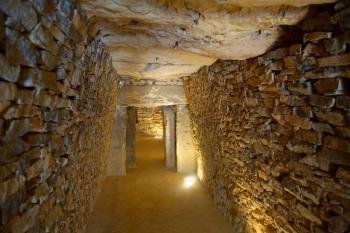
My interest for megalithic sites was aroused during a visit to Carnac in 2015, so the inscription of the Antequera Dolmens in 2016 was perfect timing to include the site in the itinerary for our Andalusia trip in September. The Antequera Dolmens WHS comprises five sites at four locations: three dolmens and two natural landmarks closely linked to the megalithic monuments.
The Dolmen de Viera and the Dolmen de Menga are located just outside Antequera on a small hill overlooking olive groves and with the view to the Pena de los Enamorados, one of the natural sites of this WHS. The visit starts in the reception centre with a short film explaining the technique that was presumably used to built the dolmens. We also learned that the landscape has significantly changed since the dolmens were built. It is believed that there were a number of lakes and ponds and forest around the tombs. Today it is the typical Andalusian landscape: dry and barren, olives seem to be the only fruit growing there.
The Menga Dolmen impresses by its size, the oval interior is several metres wide and more than three metres high, you can stand upright everywhere. The side walls consist of massive stone blocks and the covering slabs are supported by three pillars. The largest stone is estimated to be 180 tons, much heavier than the largest stone in Stonehenge. Thus, it is quite obvious why the period is named "megalithic" (mega = large, lithos = stone). When you look through the entrance you see the Pena de los Enamorados, which has the shape of a lying face from this angle. And it is also the position where the sun rises during summer solstice. Visitors can witness this event, but you have to pre-book a ticket at the reception centre.
The Viera Dolmen is only a few steps away and dates from the same time as the Dolmen de Menga, the age is estimated to be 5000 years. From the outside, both dolmens are about the same size, but the Viera Dolmen has a smaller interior: a long narrow passage, half of the length uncovered, leads to a small rectangular burial chamber.
The Tholos of El Romeral (photo) is about 4 km away in an industrial area, you would not expect a burial place there. The site is easy to find and well signposted, it's only a few minutes by car, and the lady at the reception centre at the Menga Dolmen explained in detail how we had to drive. El Romeral is younger than the other two dolmens, it dates from about 2000 BC. A long corridor leads to a high, domed chamber and a smaller chamber behind it. The architecture is different from the Menga and Viera dolmens: the walls of the corridor and the domed chamber consist of drystone walls, large stones were used only for the covering slabs and the door frames to the chamber. The entrance is aligned to the El Torcal mountain range, the second natural landmark of this WHS, and points to its highest peak. Although the large stone blocks of the Menga Dolmen are very impressive, I liked best El Romeral because of the dome-shaped chamber and the regular structure of stone walls.
The entrance to the dolmens is free, but there were only a few people around. However, this may change after inscription, Malaga and the Costa del Sol is only about 50 km away and it is expected that bus tours are organized from the popular seaside resorts.
El Torcal is a spectacular karst landscape, about 10 km south of Antequera, 20 minutes by car up to the visitor center. The connection to the dolmens is established by remains of human settlement from the Neolithic period that were found in limestone caves. The nature park is very popular with tourists, no surprise, it is great fun to hike between the craggy rocks. It is a bizarre labyrinth: stone pillars and ruggy cliffs, high 'stacks' of stone slabs, that look like artificially assembled. There are two circular hiking trails starting from the visitor center: marked in yellow (about two hours) and green (one hour), the green trail is identical to the first and last sections of the yellow trail. The trails are easy, without steep sections, but rocky, so solid shoes are recommended. We took the yellow trail and enjoyed our hike a lot, but if you have little time you will get a good impression of the site when you take the shorter route.
The second natural component, the Pena de los Enamorados, seems to be much harder to access. At least, there is no marked trail to the top. The A-7282 passes the mountain, but there is a railway line, a ditch and a high fence between the road and the rock. However, seen from close the mountain is not very impressive, really remarkable is the view from Antequera. There are several viewing points, eg from the Avenida de la Legion, just outside Antequera, where you have the view to the city and the Alcazar with the Pena de los Enamorados in the background.
Actually, we visited the natural sites first, simply because we arrived on Monday afternoon when the dolmens are closed. So we had to stay overnight in Antequera. Certainly, most WH travellers will spend only a few hours in Antequera and visit this WHS on a detour between Granada and Sevilla or Gibraltar or on a daytrip from Granada (100 km). This is easily possible because - quite unusual for Andalusia - the opening hours are from 9 am to 6.30 pm (closed on Mondays) without a siesta break.
All in all, Antequera was a worthwhile stopover on our Andalusia trip, the WHS is a nice combination of megalithic monuments and natural landscapes.
More on
Comments
No comments yet.
